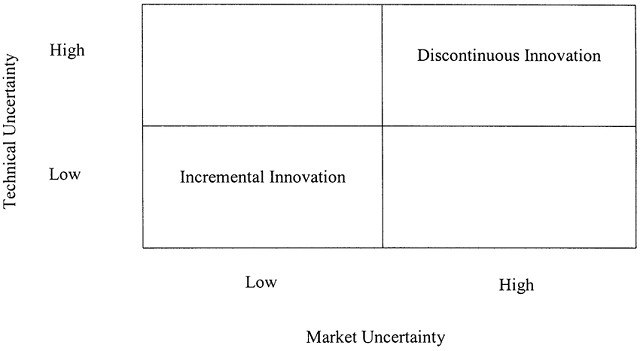In the dynamic landscape of technological progress and business evolution, innovation stands as the cornerstone of growth and sustainability. While many are familiar with the concept of innovation, have you ever wondered about the extraordinary possibilities that “disruptive innovation” holds?
Imagine a realm where conventional paradigms are shattered, giving way to revolutionary advancements that redefine industries. Discontinuous Innovation is built upon new knowledge, resources, and competencies that are entirely novel to sector companies (Freeman, 1994).
In this article, we delve into the realm of “Discontinuous Innovation,” exploring its definition, benefits, dynamic aspects, and real-world examples. Join us on this intellectual journey as we unravel the enigmatic power of innovation that challenges conventions.
What is Discontinuous Innovation? Beyond the Ordinary
In essence, Discontinuous Innovation transcends mere incremental improvements and ventures into unfamiliar territory. Birkinshaw et al. (2007) define Discontinuous Innovation as “new technologies, products, or business models that represent a dramatic departure from the current state of the art in an industry; and require companies to find and establish relationships with a variety of external parties, including suppliers.”
Unlike its incremental counterpart that refines existing products or processes, Discontinuous Innovation dares to redefine the very foundations upon which industries are built. In this sense, these innovations often necessitate new business models to succeed in the market; new business models may even be considered a crucial part of disruptive innovation (Kishna et al., 2017).
It entails revolutionary changes, often accompanied by paradigm shifts, reshaping markets, customer expectations, and the competitive landscape. Discontinuous Innovation is frequently also referred to as disruptive innovation; however, in our article on innovation, we present different classifications of innovation types.
Benefits of Discontinuous Innovation
The benefits of Discontinuous Innovation are as profound as they are transformative. Embracing this approach opens doors to exceptional competitive advantages, propelling organizations to the forefront.
Discontinuous Innovation is characterized by the novelty of technology and greater uncertainty, with effects on both the market and the company itself (Knuepling et al., 2022).
By redefining the boundaries of what is possible, companies can create new markets, establish unassailable market positions, and foster customer loyalty beyond imagination.
Kishna et al. (2017) point out that common sources of Discontinuous Innovation in mature industries identified in the fields of industrial dynamics, strategic management, and innovation systems include: exogenous shocks, technological developments, market changes, and new competitors.
In this way, Discontinuous Innovation enables companies to quickly adapt to changing environments. In a world where stagnation can lead to obsolescence, this form of innovation drives rapid evolution. Companies can swiftly respond to disruptions, seize opportunities, and drive sustained growth.
Dynamically Discontinuous Innovation: Riding the Wave of Change
While Discontinuous Innovation itself is transformative, it is essential to recognize that not all innovations are equal. The concept of dynamically disruptive innovation acknowledges the constantly evolving nature of change.
Innovations that are dynamically disruptive adapt to changes in technology, markets, and consumer behaviors. This adaptability is the vital element for sustained success in an ever-changing world.
Examples of Discontinuous Innovation
To truly grasp the potential of Discontinuous Innovation, let’s explore some compelling examples. The following examples illustrate how Discontinuous Innovation can transform entire industries, change the way people live and work, and open up new opportunities that were previously unimaginable. The ability to break from the status quo and create radically new solutions is a testament to the power of Discontinuous Innovation.
Tesla
Consider the innovative shift brought about by Tesla’s electric vehicles. This innovation revolutionized the automotive industry, sparking a revolution that challenged traditional combustion engines and pushed boundaries.
In this regard, Wang et al. (2018) examined the interaction between industrial modularity and Discontinuous Innovation in the automobile industry and found that there is a long-term dynamic equilibrium between disruptive innovation and industrial modularity.
Apple
Before the introduction of smartphones, mobile phones were primarily communication devices limited to calls and text messages. However, with the introduction of Apple’s iPhone in 2007, a Discontinuous Innovation occurred that completely changed the way people interact with technology.
Smartphones combined functions like calls, messaging, internet browsing, apps, and cameras into a single device. This transformation revolutionized the mobile phone industry, creating an entirely new market and changing how people connect, work, and entertain themselves.
3D Printing and Custom Manufacturing
3D printing marked a Discontinuous Innovation in the manufacturing industry. Unlike traditional manufacturing methods that required molds and complex processes, 3D printing allowed for the creation of three-dimensional objects layer by layer from digital designs.
This technology revolutionized customization and agility in production. Applications range from rapid prototyping to manufacturing custom spare parts, impacting industries from medicine to automotive.
Discontinuous Innovation or Incremental Innovation?
It’s important to note that in the literature when innovation is “exceptional,” it is often labeled as “radical,” “discontinuous,” “disruptive,” or “revolutionary,” while ordinary innovations are termed “continuous” or “incremental” (Knuepling et al., 2022). For the purpose of the comparison presented in Table 01, we will use the classification of “incremental innovation” and “disruptive innovation.”
Table 01. Comparison of Incremental Innovation and Discontinuous Innovation.
| Aspect | Incremental Innovation | Discontinuous Innovation |
| Focus | Gradual improvements in products and processes | Radical changes and transformations |
| Goal | Constant refinement | Breakthrough and creation of something new |
| Risk | Low risk due to gradual changes | Higher risk due to bold changes |
| Market Impact | Continuous improvement of existing products | Creation of new markets and opportunities |
| Rate of Change | Less disruptive, gradual change | Rapid and bold change |
| Stability | Maintains stability and efficiency | Can cause short-term instability |
| Adaptability | Adaptable to small changes in the environment | Adaptation to significant changes |
| Continuous Innovation | Small advancements over time | Transformations at intervals |
| Examples | Software updates | Invention of electricity or the Internet |
| Common Use | Enhancement of manufacturing processes | Revolutionizing entire industries |
Remember that the choice between these approaches will depend on the situation, objectives, and specific context of the organization. Each type of innovation has its own advantages and challenges, and the right combination can make a difference in an organization’s ability to grow, adapt, and remain competitive in an ever-changing business environment.

How to Implement Discontinuous Innovation Processes
A starting point for embarking on Discontinuous Innovation processes is to analyze your skills and capabilities. Moreno (2022) reports that values such as creativity, risk-taking, and the willingness to let go of prior knowledge in favor of learning new skills are more closely associated with disruptive innovation.
Additionally, Knuepling et al. (2022) emphasize that the primary requirements for Discontinuous Innovation processes are progressive structures (both internal and external) related to change and creation, changes in human resources, and significant external changes (environment).
On the other hand, it’s generally thought that all companies should be “innovation creators”; however, it’s important to recognize that companies often also function as “innovation buyers” (Ghezzi et al., 2015).
Usually, companies initiating Discontinuous Innovation processes rely on external technology providers; in this regard, Mahmoud-Jouini and Charue-Duboc (2019) identified the following criteria for engaging with suppliers and potential partners in innovation processes:
- A documented mapping that combines identified concepts of disruptive innovation and their underlying technologies with potential suppliers who lead and can provide these technologies;
- A structured and transparent process that supports mutual and progressive engagement;
- A dedicated entity, specific and separate from the rest of the company, yet simultaneously connected to experts who hold internal knowledge to merge with leveraged external knowledge, as well as senior executives who will make decisions regarding the future development of opportunities explored for disruptive innovation.
Similarly, Ghezzi et al. (2015) reveal that an exogenous Discontinuous Innovation first affects the parameters of the proposed value business model and financial configuration; in turn, the company aligns its key resources, key activities, key partners, and key dynamic capabilities with the emerging context.
Conclusion: Embracing the Discontinuous Frontier
In the realm of business evolution, Discontinuous Innovation stands as a beacon of transformative power. It’s a bold departure from the ordinary, a journey that redefines industries and propels organizations to unprecedented heights.
By embracing the spirit of dynamic change, companies can harness the benefits of innovation to stay at the forefront in an ever-evolving world. So, as we conclude this exploration, consider the boundless possibilities that unfold when we dare to innovate beyond the bounds of convention.
As you embark on your journey to understand Discontinuous Innovation, remember that this article has only scratched the surface. The landscape of innovation is vast and ever-evolving, with new paradigms waiting to be shattered and new potentials waiting to be realized. Welcome to the realm where innovation challenges conventions, and the future is shaped by those who dare to reinvent it.
Bibliographic References
Birkinshaw, J., Bessant, J., & Delbridge, R. (2007). Finding, Forming, and Performing: Creating Networks for Discontinuous Innovation. California Management Review, 49(3), 67–84. https://doi.org/10.2307/41166395
Ghezzi, A., Cavallaro, A., Rangone, A., & Balocco, R. (2015). On business models, resources and exogenous (dis) continuous innovation: evidences from the mobile applications industry. International Journal of Technology Management, 68(1-2), 21-48.
Kishna Maikel, Simona Negro, Floortje Alkemade & Marko Hekkert (2017) Innovation at the end of the life cycle: discontinuous innovation strategies by incumbents, Industry and Innovation, 24:3, 263-279, DOI: 10.1080/13662716.2016.1226163
Knuepling, Louis; Wessendorf, Colin; Basilico, Stefano (2022) : Revisiting innovation typology: A systemic approach, Jena Economic Research Papers, No. 2022-002, Friedrich Schiller University Jena, Faculty of Economics and Business Administration, Jena
Mahmoud-Jouini, S. B., & Charue-Duboc, F. (2019). Establishing relationships with distant suppliers to explore discontinuous innovation. International Journal of Technology Management, 81(3-4), 143-165.
Moreno Luzón, M. D. (2022). Innovation and Ambidexterity.
WANG Hai-long, HUANG Ming, LIN De-ming. Effects of Industrial Modularization on Discontinuous Innovation: An Empirical Analysis in Automobile Industry[J]. Operations Research and Management Science, 2018, 27(9): 99-104.
Editor and founder of “Innovar o Morir” (‘Innovate or Die’). Milthon holds a Master’s degree in Science and Innovation Management from the Polytechnic University of Valencia, with postgraduate diplomas in Business Innovation (UPV) and Market-Oriented Innovation Management (UPCH-Universitat Leipzig). He has practical experience in innovation management, having led the Fisheries Innovation Unit of the National Program for Innovation in Fisheries and Aquaculture (PNIPA) and worked as a consultant on open innovation diagnostics and technology watch. He firmly believes in the power of innovation and creativity as drivers of change and development.





